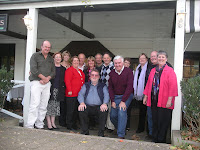
Mary and I visited Berrima on the weekend to celebrate the 60th Birthday of our good friend Rob. We dined at the Magpie Cafe. The food was great and the atmosphere relaxed, and a good day was had by all.
Took some interesting photos as shown above:
- Lambie's Well - first water supply for the town situated just below the western wall of the Gaol on the banks of the Wingecarribee River.
- Bulls Head Fountain on the northern wall of the Gaol. Built to provide water for the horses of those attending the Courthouse opposite.
- Our group.
History Services NSW has extensive historical information in our databases relating to the Berrima district including:
- 643 records of convicts who were at Berrima at some time;
- 180 records of Government contracts awarded for work in and around Berrima- repairs to the Gaol (1860) and additions thereto (1862); repairs to the Telegraph Station (1865); erection of a boundary wall around the Goal (1865); supply of furniture for the Courthouse (1871, 1877); erection of Police Station (1877); erection of Chimney Stack at the Courthouse (1892); installation of electric light at Berrima Gaol (1894);repairs to the Courthouse (1897);
- records of all the licensees of the Surveyor General Inn up to 1900
http://www.historyservices.com.au/



